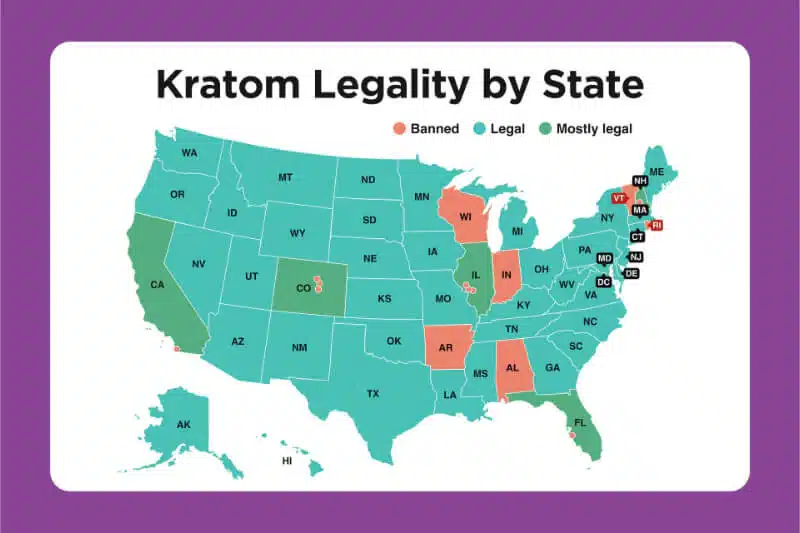Kratom is an herbal extract that has controversies and interest around its effects and applications in alternative medicine. This tropical herb has long been utilized in traditional medicine across Southeast Asia. However, with potential benefits, there are associated risks that must be understood.
In this guide, we dive deeper into what kratom is, its potential benefits, and side effects. Let’s explore the science and concerns surrounding kratom.
Sections
ToggleWhat Is Kratom?

Kratom, scientifically known as Mitragyna speciosa, is a herb derived from a tropical evergreen tree belonging to the coffee family, indigenous to Thailand, Malaysia, Indonesia, Myanmar, and Papua New Guinea. In botany, the kratom term is used for a plant whose leaves contain psychoactive alkaloids, primarily mitragynine and 7-hydroxymitragynine. In Western markets, kratom is sold as an herbal supplement for pain relief, mood enhancement, and assistance with opioid withdrawal.
Kratom is commonly consumed in various forms:
- Powder: Dried kratom leaves are ground into a powder used in beverages, encapsulated, or used to make tea.
- Capsules: Pre-measured dosage gelatin kratom capsules are available
- Extracts: Concentrated liquid or resin forms of kratom that have higher alkaloid concentrations
- Tea: Traditional tea prepared by steeping kratom leaves or powder in hot water, often with lemon juice
What Is Kratom Used For?

If you are wondering what kratom is used for, its applications range from pain management to stress relief.
1. Pain Management
The alkaloids present in kratom can interact with the body’s opioid receptors, resulting in analgesic effects similar to painkillers. From chronic to acute pain relief, it is used for managing conditions like arthritis, fibromyalgia, back pain, and post-surgical discomfort. A major benefit of using kratom for pain management is that, unlike prescription painkillers, it provides relief without respiratory depression.
2. Mood Enhancement and Anxiety Relief
Kratom has found a niche market in the mental wellness segment. People are using it for preventing depression symptoms, social anxiety, and general mood elevation. The alkaloids in the herb influence neurotransmitter systems including serotonin and dopamine, resulting in anxiolytic and antidepressant effects.
3. Energy and Focus Boost
At lower doses, kratom can act as a natural energy enhancer and boost cognitive performance. In controlled dosage, it can increase alertness, physical stamina, sociability, and mental clarity.
4. Support During Opioid Withdrawal
The most highlighted benefit among kratom uses is for self-treatment of opioid dependence. Individuals struggling with opioid addiction can manage withdrawal symptoms. The herb has partial opioid agonist properties that may ease cravings, anxiety, pain, and other withdrawal discomforts.
How Kratom Works in the Body?
Kratom effects on the body result from the primary alkaloids mitragynine and 7-hydroxymitragynine. These compounds bind to mu-opioid receptors in the brain while also affecting adrenergic and serotonergic systems. The dosage drastically varies the effects one can experience from kratom use. Unlike full opioid agonists such as morphine or oxycodone, kratom alkaloids act as partial agonists.
- Low doses (1–5 grams): At this dose, kratom effects are limited to increased energy, alertness, sociability, and mild euphoria similar to caffeine but more pronounced.
- Moderate doses (5–15 grams): A balance of pain relief, relaxation, mood improvement, and mild sedation with some opioid-like properties is experienced at this dosage.
- High doses (15+ grams): In large doses, kratom can cause strong sedative and analgesic effects resulting in euphoria, drowsiness, and a significantly increased risk of kratom side effects.
Common Effects of Kratom
Understanding kratom effects is essential to make an informed decision and manage the health warnings:
Positive or Desired Effects
- It provides natural stimulation in small doses, causing increased energy and focus, helping with work, study, or physical activities.
- Pain relief ranging from mild to substantial, depending on dosage taken and individual response.
- Positive mood elevation and gentle euphoria often lead to improvement in emotional well-being.
- Calming effects resulting in anxiety reduction and depression prevention.
- Help with social inhibition, making interactions feel more natural and enjoyable.
Negative or Undesired Effects
- At higher dosages, kratom use can result in nausea and vomiting
- Individuals with high sensitivity can experience dizziness and lightheadedness
- Dry mouth and dehydration requiring increased fluid intake
- Confusion and cognitive impairment can result from high consumption, interfering with routine tasks
- Regular, prolonged use can cause dependence and withdrawal symptoms
Potential Side Effects and Health Risks

Depending on individual tolerance and dosage, kratom side effects can range from short-term to long-term:
Short-Term Side Effects
- Constipation is often caused by regular use
- Loss of appetite
- Sweating due to autonomic responses to alkaloid metabolization
- Itching from opioid-induced pruritus
- Increased urination
Long-Term Health Risks
Chronic kratom usage can cause more serious health risks:
- Physical dependence and addiction
- Liver damage is reported in some cases
- Weight loss from sustained appetite suppression
- Sleep disturbances during withdrawal attempts
- Hyper pigmentation is reported among heavy, long-term users
Kratom Dosing and Usage Guidelines
Due to variation in kratom leaves’ potency and alkaloid content, determining accurate dosage can be tricky. The best kratom usage strategy is to begin with lower doses and gradually adjust based on effects and tolerance development.
Dosage Range | Effect |
1–5 grams |
|
5–10 grams |
|
10–15 grams |
|
15+ grams |
|
Safety Tips:
- Start with the lowest effective dose, typically 1-2 grams, to experience effects and sensitivity
- Avoid daily use to minimize the risk of addiction
- Stay hydrated when consuming kratom to prevent constipation
- Never combine kratom with other substances, particularly opioids, benzodiazepines, or alcohol
- Buy only from reputable vendors providing a third-party lab testing report
Legal Status and Regulation of Kratom

Kratom has a troubled legal status, which dramatically varies worldwide and across US jurisdictions. In several countries, including Australia, Malaysia, and several European nations, kratom is banned entirely. In the United States, kratom remains legal at the federal level; however, the FDA has not approved it for any medical use. Legal status also varies by US states, with six states (Alabama, Arkansas, Indiana, Rhode Island, Vermont, and Wisconsin) altogether banning kratom.
Conclusion
Understanding what kratom is, its biochemistry, and effects is essential for exploring its potential therapeutic applications. It can help with pain management, mood enhancement, and opioid withdrawal support, but kratom side effects and health risks are also a genuine concern. The absence of FDA approval and limited clinical research further complicate the choice. Please consult your healthcare provider about its usage, particularly the kratom drug interactions list. For safety, start with minimal doses, only buy from tested suppliers, and monitor for adverse reactions.

